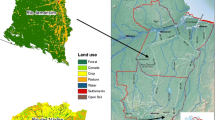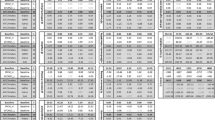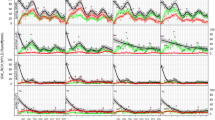Abstract
Agriculture is one of the most vulnerable economic sectors to the impacts of climate change, specifically those related with expected changes in water availability. By using a hydro-economic model, this study assesses the distributional impacts of climate change, considering the geographical location of each farmer’s community and the spatial allocation of water resources at basin scale. A hydrological model, the Soil and Water Assessment Tool model, describes the basin hydrology, while farmers’ economic responses are represented using a non-linear agricultural supply model. We simulated a reduction in both water endowment—by perturbing the hydrologic model with a regionalized climate change scenario—and agricultural yields, in order to assess the behavior of farmers’ communities. We also assessed the effectiveness of a water policy aimed at decreasing the vulnerability of farmers’ communities to climate change. At the aggregated level we found relatively small impacts, consistent with the existent literature. However, we found large distributive impacts among both farmer’s communities and agricultural activities. The water policy showed to be effective to reduce those impacts, but our results suggest the existence of unwanted effects on rainfed agriculture, as in some communities the level of income decreases when the policy is implemented.



Similar content being viewed by others
References
Arnold JG, Srinivasan R, Muttiah RS, Williams JR (1998) Large area hydrologic modeling and assessment part I: model development. doi: 10.1111/j.1752-1688.1998.tb05961.x
Bates BC, Kundzewicz ZW, Wu S, Palutikof JP Eds (2008) Climate change and water. Technical paper of the intergovernmental panel on climate change, IPCC Secretariat, Geneva 210 pp
Bekchanov M, Ringler C, Bhaduri A, Jeuland M (2016) Optimizing irrigation efficiency improvements in the Aral Sea Basin. Water Resources and Economics 13:30–45. doi:10.1016/j.wre.2015.08.003
Blanco M, Cortignani R, Severini S (2008) Evaluating changes in cropping patterns due to the 2003 CAP reform. An ex-post analysis of different PMP approaches considering new activities. In Comunicación presentada al 107th EAAE Seminar “Modelling of Agricultural and Rural Development Policies”, Sevilla
Blanco-Gutiérrez I, Varela-Ortega C, Purkey DR (2013) Integrated assessment of policy interventions for promoting sustainable irrigation in semi-arid environments: a hydro-economic modeling approach. J Environ Manag 128:144–160. doi:10.1016/j.jenvman.2013.04.037
Braat LC, Van Lierop WF (1986) Economic-ecological modeling: an introduction to methods and applications. Ecol Model 31(1):33–44. doi:10.1016/0304-3800(86)90053-0
Britz W, Witzke P (2008) CAPRI model documentation 2008: version 2. Institute for Food and Resource Economics, University of Bonn, Bonn
Brouwer R, Hofkes M (2008) Integrated hydro-economic modelling: approaches, key issues and future research directions. Ecol Econ 66(1):16–22. doi:10.1016/j.ecolecon.2008.02.009
Cai X, McKinney DC, Lasdon LS (2003) Integrated hydrologic-agronomic-economic model for river basin management. J Water Resour Plan Manag 129(1):4–17. doi:10.1061/(ASCE)0733-9496(2003)129:1(4)
Cai X, Ringler C, You JY (2008) Substitution between water and other agricultural inputs: implications for water conservation in a river basin context. Ecol Econ 66(1):38–50. doi:10.1016/j.ecolecon.2008.02.010
Donoso G (2006) Water markets: case study of Chile’s 1981 Water Code. Cien Inv Agr 33(2):157–171. Ciencia e Investigación Agraria 33(2) 131–146. doi: 10.4067/rcia.v33i2.1299
ECLAC (2015) The economics of climate change in Latin America and the Caribbean Paradoxes and challenges of sustainable development. Retrieved Feb 2017, from http://repositorio.cepal.org/bitstream/handle/11362/37311/S1420655_en.pdf
Esteve P, Varela-Ortega C, Blanco-Gutiérrez I, Downing TE (2015) A hydro-economic model for the assessment of climate change impacts and adaptation in irrigated agriculture. Ecol Econ 120:49–58. doi:10.1016/j.ecolecon.2015.09.017
Fernández FJ, Ponce RD, Blanco M, Rivera D, Vásquez F (2016) Water variability and the economic impacts on small-scale farmers. A farm risk-based integrated modelling approach. Water Resour Manag 30(4):1357–1373. doi:10.1007/s11269-016-1227-8
Foster W, López de Lérida J, Valdes A (2011) Impacto del nivel de distorsiones en el sector agrícola nacional. Ministerio de Agricultura, Pontificia Universidad Católica de Chile, Departamento de Economía Agraria, Santiago, Chile
Graveline N, Majone B, Van Duinen R, Ansink E (2014) Hydro-economic modeling of water scarcity under global change: an application to the Gállego river basin (Spain). Reg Environ Chang 14(1):119–132. doi:10.1007/s10113-013-0472-0
Harou JJ, Pulido-Velazquez M, Rosenberg DE, Medellín-Azuara J, Lund JR, Howitt RE (2009) Hydro-economic models: concepts, design, applications, and future prospects. J Hydrol 375(3):627–643. doi:10.1016/j.jhydrol.2009.06.037
Heinz I, Pulido-Velazquez M, Lund JR, Andreu J (2007) Hydro-economic modeling in river basin management: implications and applications for the European water framework directive. Water Resour Manag 21(7):1103–1125. doi:10.1007/s11269-006-9101-8
Heckelei T (2002) Calibration and estimation of programming models for agricultural supply analysis. Habilitation thesis. University of Bonn, Germany. Retrieved Feb 2017, from http://www.ilr.uni-bonn.de/agpo/staff/heckelei/heckelei_hab.pdf
Heckelei T, Britz W (2005) Models based on positive mathematical programming: state of the art and further extensions p 48–73. Modelling agricultural policies: state of the art and new challenges. Proceedings of the 89th European Seminar of the EAAE, Parma. 3–5 Feb. University of Parma, Department of Economic and Quantitative Studies, Parma, Italy
Howitt RE (1995) Positive mathematical programming. Am J Agric Econ 77(2):329–342. doi:10.2307/1243543
Howitt RE, MacEwan D, Medellín-Azuara J, Lund JR (2010) Economic modeling of agriculture and water in California using the statewide agricultural production model. University of California, Davis, CA
Hurd BH (2015) Concepts and methods for assessing economic impacts from climate change on water resources. Handbook of Water Economics 56. doi: 10.4337/9781782549666.00009
Hurd BH, Coonrod J (2012) Hydro-economic consequences of climate change in the upper Rio Grande. Clim Res 53(2):103. doi:10.3354/cr01092
INDAP (2014) Encuesta de Diagnostico PRODESAL - PDTI - SAT. Instituto de Desarrollo Agropecuario, Chile
INE (2007) Censo Agropecuario y Forestal. Instituto Nacional de Estadísticas, Chile
IPCC (2013) Climate change 2013: the physical science basis. Contribution of working group I to the fifth assessment report of the intergovernmental panel on climate change. In: Stocker TF, Qin D, Plattner G-K, Tignor M, Allen SK, Boschung J, Nauels A, Xia Y, Bex V, Midgley PM (eds). Cambridge University Press, Cambridge, United Kingdom and New York, NY, USA, 1535 pp
IPCC 2014 Climate change 2014: impacts, adaptation, and vulnerability. Part A: global and sectoral aspects. Contribution of working group II to the fifth assessment report of the intergovernmental panel on climate change. In: Field CB, Barros VR, Dokken DJ, Mach KJ, Mastrandrea MD, Bilir TE, Chatterjee M, Ebi KL, Estrada YO, Genova RC, Girma B, Kissel ES, Levy AN, MacCracken S, Mastrandrea PR, White LL (eds). Cambridge University Press, Cambridge, United Kingdom and New York, NY, USA, 1132 pp
Jiang Q, Grafton RQ (2012) Economic effects of climate change in the Murray–Darling Basin, Australia. Agric Syst 110:10–16. doi:10.1016/j.agsy.2012.03.009
Maneta M, Torres M, Vosti SA, Wallender WW, Allen S, Bassoi LH et al (2009a) Assessing agriculture–water links at the basin scale: hydrologic and economic models of the São Francisco River Basin, Brazil. Water Int 34(1):88–103. doi:10.1080/02508060802669496
Maneta MP, Torres MDO, Wallender WW, Vosti S, Howitt R, Rodrigues L, ..., Panday S (2009b) A spatially distributed hydroeconomic model to assess the effects of drought on land use, farm profits, and agricultural employment. Water Resour Res 45(11). doi: 10.1029/2008WR007534
McKinney DC, Cai X, Rosegrant MW, Ringler C, Scott CA (1999) Modeling water resources management at the basin level: review and future directions. Colombo, Sri Lanka: International Water Management Institute (IWMI). ix, 59p. (SWIM paper 6)
Medellín-Azuara J, Howitt RE, MacEwan DJ, Lund JR (2011) Economic impacts of climate-related changes to California agriculture. Clim Chang 109:387–405. doi:10.3910/2009.371
MINAGRI-MMA (2013) Plan Nacional de Adaptación al Cambio Climático 2008-2012. Ministry of Agriculture and Ministry for the Environment, Santiago, Chile, p 65
MMA (2016) National Climate Change Action Plan 2017–2022. Ministry for the Environment, Santiago, Chile, p 52
MOP (2012) Estrategia Nacional de Recursos Hídricos 2012-2025. Retrieved August 2016, from www.mop.cl/documents/enrh_2013_ok.pdf
Nakicenovic N, Alcamo J, Davis G, de Vries HJM, Fenhann J, Gaffin S, Gregory K, Grubler A, Jung TY, Kram T, La Rovere EL, Michaelis L, Mori S, Morita T, Papper W, Pitcher H, Price L, Riahi K, Roehrl A, Rogner H-H, Sankovski A, Schlesinger M, Shukla P, Smith S, Swart R, van Rooijen S, Victor N, Dadi Z, Nakicenovic N, Swart R (2000) (Eds) UK. pp 570. Special report on emissions scenarios, IPCC, Cambridge University Press, Cambridge, UK. pp 570
ODEPA (2010a) Estimación del impacto socioeconómico del cambio climático en el Sector Silvoagropecuario de Chile, Oficina de Estudios y Políticas Agrarias (ODEPA)
ODEPA (2010b) Series de Precios. Retrieved July 2010, 2010, from http://www.odepa.cl
Peña-Haro S, Llopis-Albert C, Pulido-Velazquez M, Pulido-Velazquez D (2010) Fertilizer standards for controlling groundwater nitrate pollution from agriculture: El Salobral-Los Llanos case study, Spain. J Hydrol 392(3):174–187. doi:10.1016/j.jhydrol.2010.08.006
Peña-Haro S, Pulido-Velazquez M, Llopis-Albert C (2011) Stochastic hydro-economic modeling for optimal management of agricultural groundwater nitrate pollution under hydraulic conductivity uncertainty. Environ Model Softw 26(8):999–1008. doi:10.1016/j.envsoft.2011.02.010
Ponce R, Blanco M, Giupponi C (2014) The economic impacts of climate change on the chilean agricultural sector: a non-linear agricultural supply model. Chilean Journal of Agricultural Research 74(4):404–412. doi:10.4067/S0718-58392014000400005
Ponce R, Blanco M, Giupponi C (2015) Welfare effects of water variability in agriculture. Insights from a multimarket model. Water 7(6):2908–2923. doi:10.3390/w7062908
Quiroz J, Labán R, Larraín F (1995) El sector agrícola y agroindustrial frente a Nafta y Mercosur. 149 p. Sociedad Nacional de Agricultura, Santiago, Chile
Riegels N, Jensen R, Bensasson L, Banou S, Møller F, Bauer-Gottwein P (2011) Estimating resource costs of compliance with EU WFD ecological status requirements at the river basin scale. J Hydrol 396(3):197–214. doi:10.1016/j.jhydrol.2010.11.005
Samaniego J, De Miguel CJ, Galindo LM, Gómez JJ, Martínez K, Cetrángolo O (2009) La economía del cambio climático en Chile: síntesis. Naciones Unidas, Santiago
Santibáñez F, Santibáñez P, Cabrera R, Solís L, Quiroz M, Hernández J (2008) Capítulo I. Resumen Ejecutivo. Impactos productivos en el sector silvoagropecuario de Chile frente a escenarios de cambio climático.In Análisis de vulnerabilidad del sector silvoagropecuario, recursos hídricos, edáficos de Chile frente a escenarios de cambio climático. Centro de Agricultura y Medioambiente (AGRIMED), Facultad de Ciencias Agronómicas, Universidad de Chile, Santiago, Chile
Stehr A, Debels P, Romero F, Alcayaga H (2008) Hydrological modelling with SWAT under conditions of limited data availability: evaluation of results from a Chilean case study. Hydrol Sci J 53(3):588–601. doi:10.1623/hysj.53.3.588
Stehr A, Aguayo M, Link O, Parra O, Romero F, Alcayaga H (2010a) Modelling the hydrologic response of a mesoscale Andean watershed to changes in land use patterns for environmental planning. Hydrol Earth Syst Sci 14:1963–1977. doi:10.5194/hess-14-1963-2010
Stehr A, Debels P, Arumí JL, Alcayaga H, Romero F (2010b) Modelación de la respuesta hidrológica al cambio climático, experiencia de dos cuencas del centro–sur Chileno. Tecnología y Ciencias del Agua 1(4):37–58
Torres MDO, Maneta M, Howitt R, Vosti SA, Wallender WW, Bassoi LH, Rodrigues LN (2012) Economic impacts of regional water scarcity in the São Francisco River Basin, Brazil: an application of a linked hydro-economic model. Environ Dev Econ 17(02):227–248. doi:10.1017/S1355770X11000362
Varela-Ortega C, Blanco-Gutiérrez I, Esteve P, Bharwani S, Fronzek S, Downing TE (2016) How can irrigated agriculture adapt to climate change? Insights from the Guadiana Basin in Spain. Reg Environ Chang 16(1):59–70. doi:10.1007/s10113-014-0720-y
Van Vuuren DP, Edmonds J, Kainuma M, Riahi K, Thomson A, Hibbard K et al (2011) The representative concentration pathways: an overview. Clim Chang 109:5–31. doi:10.1007/s10584-011-0148-z
Varela-Ortega C, Blanco-Gutiérrez I, Swartz CH, Downing TE (2011) Balancing groundwater conservation and rural livelihoods under water and climate uncertainties: an integrated hydro-economic modeling framework. Glob Environ Chang 21(2):604–619. doi:10.1016/j.gloenvcha.2010.12.001
Volk M, Hirschfeld J, Dehnhardt A, Schmidt G, Bohn C, Liersch S, Gassman PW (2008) Integrated ecological-economic modelling of water pollution abatement management options in the Upper Ems River Basin. Ecol Econ 66(1):66–76. doi:10.1016/j.ecolecon.2008.01.016
Ward FA, Pulido-Velazquez M (2008) Water conservation in irrigation can increase water use. Proc Natl Acad Sci 105(47):18215–18220. doi:10.1073/pnas.0805554105
Yang YCE, Brown CM, Yu WH, Savitsky A (2013) An introduction to the IBMR, a hydro-economic model for climate change impact assessment in Pakistan’s Indus River basin. Water Int 38(5):632–650. doi:10.1080/02508060.2013.830691
You GJY, Ringler C (2010) Hydro-economic modeling of climate change impacts in Ethiopia (No. 960). International Food Policy Research Institute (IFPRI)
Author information
Authors and Affiliations
Corresponding author
Ethics declarations
Funding
This study was funded by the International Development Research Centre (IDRC-Canada) (N° 106924-001), by the Water Research Center for Agriculture and Mining (CRHIAM) supported by CONICYT/Chile in the framework of FONDAP 2013 (N° 15130015), and the Interfaculty Research Project (2016): “Evaluacion de la Amenaza, Vulnerabilidad y Riesgo Hidrometeorologico en la Agroindustria” at Universidad del Desarrollo.
Additional information
Editor: Juan Ignacio Lopez Moreno.
Rights and permissions
About this article
Cite this article
Ponce, R.D., Fernández, F., Stehr, A. et al. Distributional impacts of climate change on basin communities: an integrated modeling approach. Reg Environ Change 17, 1811–1821 (2017). https://doi.org/10.1007/s10113-017-1152-2
Received:
Accepted:
Published:
Issue Date:
DOI: https://doi.org/10.1007/s10113-017-1152-2




